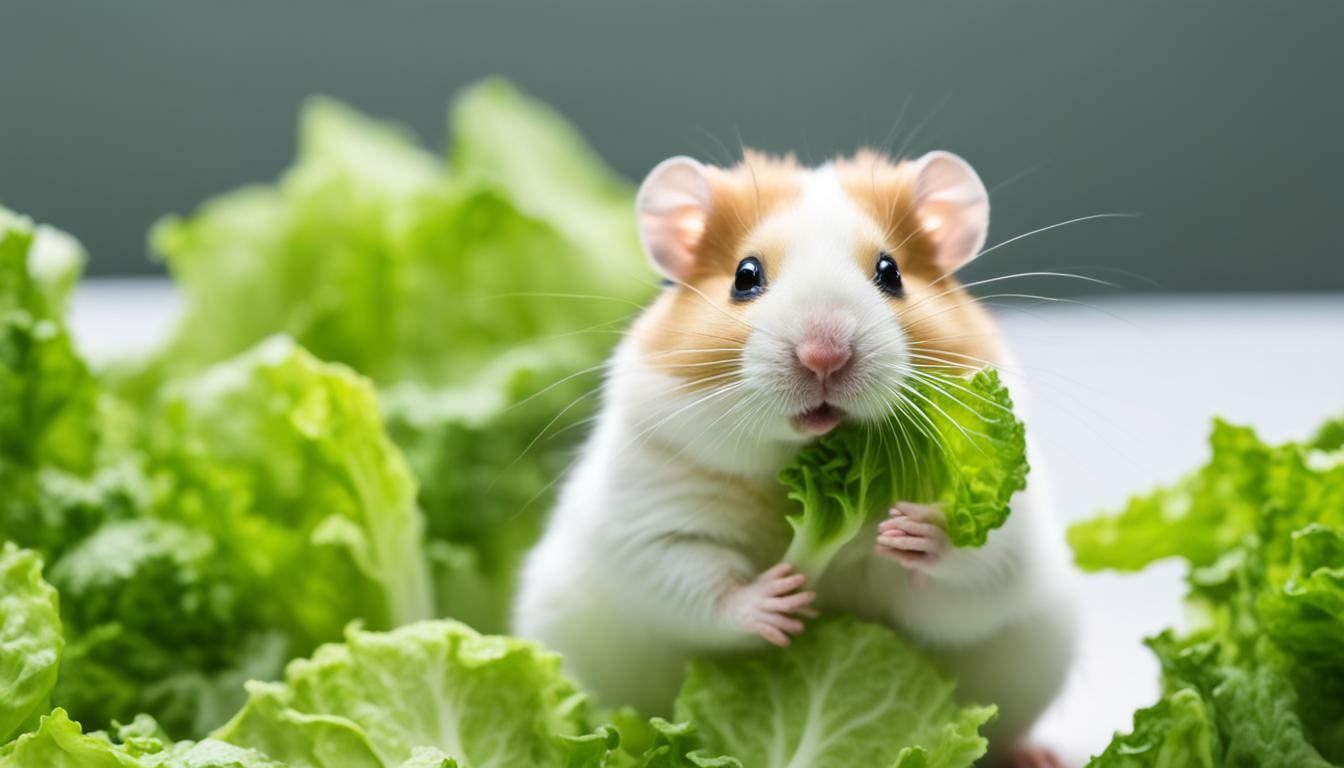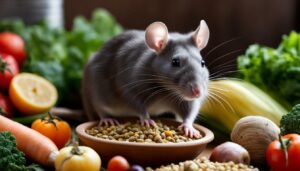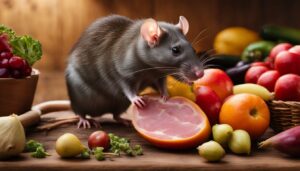If you’re wondering whether it’s safe to feed your hamster romaine lettuce, you’ve come to the right place! Hamsters can indeed enjoy romaine lettuce as a snack, but it’s important to keep moderation in mind. This leafy green contains vitamins and minerals that can benefit your hamster’s health, but overfeeding can lead to digestive issues. Let’s explore the ins and outs of feeding romaine lettuce to hamsters and how to do so safely.
Key Takeaways:
- Romaine lettuce can be safely consumed by hamsters in moderation as a snack.
- Feeding small amounts of romaine lettuce, about the size of a penny to a quarter, once a week is recommended.
- Avoid other types of lettuce, such as iceberg lettuce, which offer little nutritional value and are high in water content.
- Thoroughly wash any fresh produce, including romaine lettuce, before offering it to your hamster.
- Observe your hamster’s reaction when introducing romaine lettuce to their diet to ensure they tolerate it well.
The Nutritional Benefits of Romaine Lettuce for Hamsters
Romaine lettuce offers several nutritional benefits that can enhance your hamster’s diet. This leafy green is a good source of vitamin C, which is essential for the overall health and immune system function of your furry friend. It also contains vitamin A, which promotes healthy vision and skin.
In addition to vitamins, romaine lettuce provides important minerals like calcium and potassium. Calcium is necessary for strong bones and teeth in hamsters, while potassium helps maintain proper muscle function. These nutrients contribute to your hamster’s overall well-being.
Romaine lettuce is also low in calories and high in fiber, making it a healthy option for hamsters. The fiber content aids in digestion and can prevent constipation, which is a common issue in these small pets. Just remember to feed romaine lettuce in moderation, as excessive consumption can lead to digestive problems.
| Nutrients in Romaine Lettuce | Amount per 100g |
|---|---|
| Calories | 17 |
| Vitamin C | 24mg |
| Vitamin A | 317µg |
| Calcium | 35mg |
| Potassium | 247mg |
| Fiber | 1.2g |
Remember to introduce romaine lettuce gradually into your hamster’s diet and monitor their reaction. If you notice any adverse effects, such as diarrhea or changes in behavior, discontinue feeding romaine lettuce and consult a veterinarian. By offering romaine lettuce in small amounts alongside a balanced diet, you can provide your hamster with a nutritious treat that supports their overall health.
Feeding Romaine Lettuce to Hamsters Safely
While romaine lettuce can be a healthy addition to your hamster’s diet, it’s essential to take some precautions when offering it to them. Romaine lettuce contains vitamins and minerals that can benefit their overall health, but feeding too much can lead to stomach upset, diarrhea, and increased urination. To ensure your hamster’s well-being, follow these guidelines:
- Feed small amounts: Offer only a small portion of romaine lettuce, roughly the size of a penny to a quarter, once a week. This moderate serving size will prevent digestive issues and help maintain a balanced diet for your furry friend.
- Avoid other lettuce varieties: While romaine lettuce is safe for hamsters, avoid other types like iceberg lettuce. These varieties are high in water content and provide little nutritional value for your pet.
- Wash thoroughly: Before offering romaine lettuce or any other fresh produce to your hamster, make sure to wash it thoroughly. This step helps remove any pesticides or harmful substances that may be present on the leaves.
It’s important to remember that every hamster is different, and some may have individual dietary preferences or sensitivities. Always observe your hamster’s reaction when introducing new foods, including romaine lettuce, into their diet. If you notice any signs of discomfort or adverse effects, discontinue feeding romaine lettuce and consult a veterinarian for further guidance.
Table: Safe Foods for Hamsters
| Food | Feeding Frequency |
|---|---|
| Romaine Lettuce | Once a week, small portion |
| Carrots | Occasional treat, small portion |
| Broccoli | Once or twice a week, small portion |
| Cucumbers | Occasional treat, small portion |
Incorporating a variety of safe foods into your hamster’s diet is key to providing a balanced nutrition. Alongside romaine lettuce, carrots, broccoli, and cucumbers are nutritious options you can offer as occasional treats. Remember to always introduce new foods gradually and in moderation to avoid any digestive issues.
Moderation is Key: How Much Romaine Lettuce Can Hamsters Eat?
When it comes to romaine lettuce, moderation is key for hamsters. While romaine lettuce can be a healthy addition to their diet, feeding too much can lead to digestive issues such as stomach upset, diarrhea, and increased urination. It is important to offer romaine lettuce as a snack, rather than a staple food, and limit the portion size.
A recommended serving size for romaine lettuce is about the size of a penny to a quarter, once a week. This amount provides hamsters with the nutritional benefits of romaine lettuce without overwhelming their digestive system. Remember that hamsters have small bodies and delicate digestive systems, so it’s best to err on the side of caution.
While romaine lettuce is a safe green for hamsters, other types of lettuce, such as iceberg lettuce, should be avoided. Iceberg lettuce is high in water content and lacks significant nutritional value for hamsters. It is important to choose alternatives that offer more nutrients and fewer potential digestive issues.
| Romaine Lettuce Alternatives for Hamsters |
|---|
| Spinach |
| Kale |
| Swiss Chard |
| Arugula |
When adding romaine lettuce or any other fresh produce to your hamster’s diet, it is essential to thoroughly wash it before offering it to them. This helps remove any potential pesticides or contaminants that may be present. To wash romaine lettuce, gently rinse the leaves under cool running water and pat them dry before serving to your hamster.
Remember, variety is key when it comes to creating a balanced diet for your hamster. While romaine lettuce is a nutritious green, it should be combined with other hamster-friendly ingredients such as pellets, seeds, and occasional fruits and vegetables. This will ensure that your hamster receives a well-rounded diet that meets their nutritional needs.
Avoiding Other Types of Lettuce
While romaine lettuce is safe for hamsters, it’s best to steer clear of other lettuce types, such as iceberg lettuce. Iceberg lettuce contains high water content and offers little nutritional value for your furry friend. Opting for alternative greens will provide a more diverse and nutritious diet. Here are some romaine lettuce alternatives that hamsters can enjoy:
- Arugula: This leafy green is a great option as it is low in oxalic acid, making it safe for hamsters in moderation.
- Kale: Kale is packed with vitamins A and C, as well as calcium, making it a nutritious choice for your hamster’s diet.
- Bok Choy: Bok choy provides a good source of fiber, vitamins A and C, and calcium, all of which are beneficial for hamsters.
- Cilantro: Cilantro is a flavorful herb that contains vitamins A, C, and K, as well as antioxidants, which can contribute to your hamster’s overall health.
- Parsley: Parsley is rich in vitamins A and C, as well as iron and fiber, making it a nutritious addition to your hamster’s diet.
Remember to introduce these alternatives gradually and in small amounts to ensure your hamster’s digestive system is not overwhelmed. Monitoring your hamster’s reaction to new foods is essential to gauge any adverse effects and adjust their diet accordingly.
| Vegetable | Nutritional Benefits |
|---|---|
| Arugula | Low in oxalic acid; contains vitamins and minerals. |
| Kale | Rich in vitamins A and C, as well as calcium. |
| Bok Choy | Good source of fiber, vitamins A and C, and calcium. |
| Cilantro | Contains vitamins A, C, and K, as well as antioxidants. |
| Parsley | Rich in vitamins A and C, iron, and fiber. |
By offering a variety of nutritious greens to your hamster, you can ensure they receive a well-rounded diet. Remember to consult with a veterinarian before introducing any new foods to your pet’s diet to ensure they are suitable for their specific needs.
Washing Fresh Produce for Hamsters
Before serving romaine lettuce to your hamster, it’s crucial to wash it thoroughly to remove any potential contaminants. Hamsters are sensitive creatures, and their small bodies can easily be affected by bacteria or pesticides present on fresh produce.
To properly wash romaine lettuce, follow these steps:
- Gently separate the leaves of the romaine lettuce.
- Rinse each leaf under cool running water, making sure to remove any visible dirt or debris.
- Fill a clean sink or large bowl with water.
- Add a few drops of mild dish soap to the water and mix well.
- Submerge the romaine lettuce in the soapy water, swishing it around gently to dislodge any hidden contaminants.
- Rinse the romaine lettuce thoroughly under running water to remove any soap residue.
- Pat the leaves dry with a clean towel or use a salad spinner to remove excess moisture.
By following these steps, you can ensure that the romaine lettuce is safe for your hamster to consume. Remember to store any leftover lettuce in an airtight container in the refrigerator to maintain its freshness and nutritional value.
| Benefits of Washing Fresh Produce for Hamsters: |
|---|
| Removes potential contaminants |
| Prevents ingestion of harmful bacteria or pesticides |
| Maintains the nutritional value of the produce |
Nutritious Greens for Hamsters
In addition to romaine lettuce, there are several other leafy greens that you can offer to your hamster for a well-rounded diet. These greens are packed with essential nutrients that can contribute to your hamster’s overall health and well-being. Here are some nutritious greens that you can consider:
- Kale: Rich in vitamins A, C, and K, kale provides a variety of antioxidants that can boost your hamster’s immune system.
- Spinach: Spinach is a good source of iron, which is important for your hamster’s blood health. It also contains vitamins A and C.
- Swiss chard: This leafy green is packed with vitamins A, C, and K. It also contains magnesium, which is essential for your hamster’s bone health.
When offering these greens to your hamster, it is important to introduce them gradually and in small amounts. This will allow your hamster’s digestive system to adjust and prevent any potential stomach upset. Remember to wash these greens thoroughly before offering them to your hamster to remove any pesticides or dirt.
| Green | Benefits |
|---|---|
| Kale | Rich in vitamins A, C, and K; boosts immune system |
| Spinach | Good source of iron; contains vitamins A and C |
| Swiss chard | Packed with vitamins A, C, and K; contains magnesium for bone health |
As always, it is important to monitor your hamster’s reaction when introducing new foods into their diet. If you notice any signs of digestive issues or discomfort, it is best to consult a veterinarian. Remember that a balanced diet consists of a variety of foods, so feel free to experiment with different greens to keep your hamster happy and healthy.
Understanding the Risks of Overfeeding Romaine Lettuce to Hamsters
While romaine lettuce can be a healthy snack for hamsters, overfeeding it can lead to certain risks and health issues. It is essential to understand the importance of moderation when it comes to incorporating romaine lettuce into your hamster’s diet.
Feeding your hamster excessive amounts of romaine lettuce can result in stomach upset, diarrhea, and increased urination. These symptoms can be uncomfortable for your furry friend and may require veterinary intervention. To prevent these issues, it is recommended to offer small amounts of romaine lettuce, about the size of a penny to a quarter, once a week.
It’s worth noting that not all types of lettuce are suitable for hamsters. Iceberg lettuce, in particular, should be avoided as it contains high water content and offers little nutritional value. Instead, opt for romaine lettuce, which is richer in vitamins and minerals beneficial for your hamster’s overall health.
In addition to portion control, it is crucial to wash any fresh produce, including romaine lettuce, thoroughly before offering it to your hamster. This helps remove any potential pesticides or contaminants that may be present on the leaves. Simply rinse the romaine lettuce under running water, ensuring to remove any dirt or residue, before serving it to your furry companion.
| Pros | Cons |
|---|---|
|
|
Creating a Balanced Diet for Your Hamster
To ensure your hamster gets a balanced diet, it’s important to incorporate romaine lettuce along with other suitable food items. Romaine lettuce is a nutritious green that can provide a variety of vitamins and minerals for your furry friend. However, it should not be the sole component of their diet. Including a variety of foods will help prevent nutrient deficiencies and promote overall health.
Here are some alternatives to romaine lettuce that you can consider adding to your hamster’s diet:
- Spinach: Rich in iron and vitamin C, spinach can be a great addition to your hamster’s diet. However, it should be given in moderation as high quantities can cause calcium oxalate deposits.
- Kale: Packed with vitamin A, calcium, and fiber, kale is a nutrient-dense leafy green that can contribute to your hamster’s well-being. Serve it sparingly, as excessive consumption may lead to digestive issues.
- Carrots: Carrots are a crunchy and tasty treat that hamsters enjoy. They are a good source of vitamin A, which is important for their vision and immune system. Remember to feed carrots in moderation due to their relatively high sugar content.
Remember, when introducing new foods to your hamster, it’s important to observe their reaction and monitor any potential adverse effects. Offer small quantities at first and gradually increase the portion size if your hamster tolerates it well. Always consult with a veterinarian for specific dietary recommendations tailored to your hamster’s needs.
| Food | Nutritional Benefits |
|---|---|
| Romaine Lettuce | Rich in vitamin C and vitamin A; provides hydration |
| Spinach | High in iron and vitamin C; promotes healthy digestion |
| Kale | Excellent source of vitamin A and calcium; supports bone health |
| Carrots | Good source of vitamin A and fiber; aids in dental health |
The Importance of Observing Your Hamster’s Reaction
When introducing romaine lettuce to your hamster’s diet, it’s crucial to pay attention to their reaction and overall well-being. While romaine lettuce can be a safe and healthy addition to their meals, not all hamsters may tolerate it well. Every hamster is unique, and some may have sensitivities or allergies to certain foods, including romaine lettuce.
Start by offering a small piece of romaine lettuce, about the size of a penny to a quarter, and observe how your hamster responds. Watch for any signs of discomfort, such as changes in appetite, vomiting, or diarrhea. If you notice any negative reactions, it’s best to remove romaine lettuce from their diet and consult with a veterinarian for alternative options.
Additionally, it’s important to keep an eye on your hamster’s overall well-being when introducing new foods. Monitor their energy levels, coat condition, and stool consistency. Any significant changes in these areas could indicate an adverse reaction to romaine lettuce or other dietary issues. Regularly assessing your hamster’s health will help ensure their diet is balanced and suitable for their individual needs.
Summary of Important Points
- Introduce romaine lettuce gradually and in small portions to observe any adverse reactions.
- Look for signs of discomfort or changes in appetite, vomiting, or diarrhea.
- Monitor your hamster’s overall well-being, including energy levels, coat condition, and stool consistency.
- Consult with a veterinarian if you notice any negative reactions or significant changes in your hamster’s health.
| Key Points: | Details: |
|---|---|
| Romaine Lettuce Intake | Offer small amounts, about the size of a penny to a quarter, once a week. |
| Signs of Negative Reactions | Watch for changes in appetite, vomiting, diarrhea, or other discomfort. |
| Overall Well-being | Monitor energy levels, coat condition, and stool consistency. |
| Veterinarian Consultation | Seek professional advice if you notice adverse reactions or significant health changes. |
Introducing Variety in Your Hamster’s Diet
While romaine lettuce is a great addition to your hamster’s diet, it’s also important to offer them a variety of other greens for optimal nutrition. By incorporating different types of greens into their meals, you can ensure that your furry friend receives a balanced and diverse diet.
Some alternative options to romaine lettuce include spinach, kale, and Swiss chard. These leafy greens provide a range of vitamins and minerals that contribute to your hamster’s overall well-being. You can introduce these greens gradually by mixing small amounts with their regular food and observing their reaction. Remember to wash the greens thoroughly before offering them to your pet to remove any potential pesticides or contaminants.
| Hamster-Safe Greens | Nutritional Benefits |
|---|---|
| Spinach | Rich in iron and antioxidants |
| Kale | Excellent source of vitamin C and calcium |
| Swiss Chard | High in vitamins A and K |
It’s essential to maintain moderation when introducing new greens to your hamster’s diet. Remember that treats and vegetables should only make up a small portion of their overall food intake. The bulk of their diet should consist of a high-quality hamster pellet or mix that provides all the necessary nutrients.
By offering a variety of greens to your furry friend, you can provide them with a diverse and nutrient-rich diet. Remember to consult with a veterinarian specializing in small animals to ensure you’re providing the best possible nutrition for your hamster.
Conclusion
In conclusion, romaine lettuce can be safely incorporated into a hamster’s diet in moderation, offering several nutritional benefits. This leafy green vegetable is rich in vitamins and minerals that can support your hamster’s overall health and well-being. However, it is important to remember that too much romaine lettuce can lead to stomach upset, diarrhea, and increased urination.
To ensure the well-being of your furry friend, it is recommended to only feed small amounts of romaine lettuce as a treat, about the size of a penny to a quarter, once a week. This will provide them with the nutritional benefits without overwhelming their digestive system.
While romaine lettuce is a suitable addition to a hamster’s diet, it is essential to avoid other types of lettuce, such as iceberg lettuce. Iceberg lettuce is high in water content and offers little nutritional value for your hamster. It is best to stick to romaine lettuce as the preferred green for your pet.
Furthermore, it is crucial to practice good hygiene when feeding romaine lettuce or any fresh produce to your hamster. Always wash the lettuce thoroughly before offering it to your furry friend to remove any potential contaminants. This simple step can help prevent any adverse reactions or digestive issues.
FAQ
Can hamsters eat romaine lettuce?
Yes, hamsters can eat romaine lettuce in moderation as a snack.
What are the nutritional benefits of romaine lettuce for hamsters?
Romaine lettuce contains vitamins and minerals that can be beneficial for a hamster’s health.
How much romaine lettuce should I feed my hamster?
It is recommended to feed hamsters small amounts of romaine lettuce, about the size of a penny to a quarter, once a week.
Can hamsters eat other types of lettuce?
Other types of lettuce, such as iceberg lettuce, should be avoided as they are high in water and offer little nutritional value.
Should I wash romaine lettuce before giving it to my hamster?
Yes, it is important to wash any fresh produce, including romaine lettuce, thoroughly before offering it to a hamster.
What are some alternative greens that I can feed my hamster?
Other nutritious greens that are suitable for hamsters include spinach, kale, and Swiss chard.
What are the risks of overfeeding romaine lettuce to hamsters?
Overfeeding romaine lettuce can cause stomach upset, diarrhea, and increased urination in hamsters.
How can I create a balanced diet for my hamster?
To create a balanced diet for your hamster, you can combine romaine lettuce with other hamster-friendly ingredients like pellets, seeds, and protein sources.
Why is it important to observe my hamster’s reaction to romaine lettuce?
Observing your hamster’s reaction to romaine lettuce can help you monitor for any adverse effects or allergies.
Can I introduce variety in my hamster’s diet?
Yes, it is important to introduce variety in your hamster’s diet by incorporating different types of greens and other nutritious foods.




